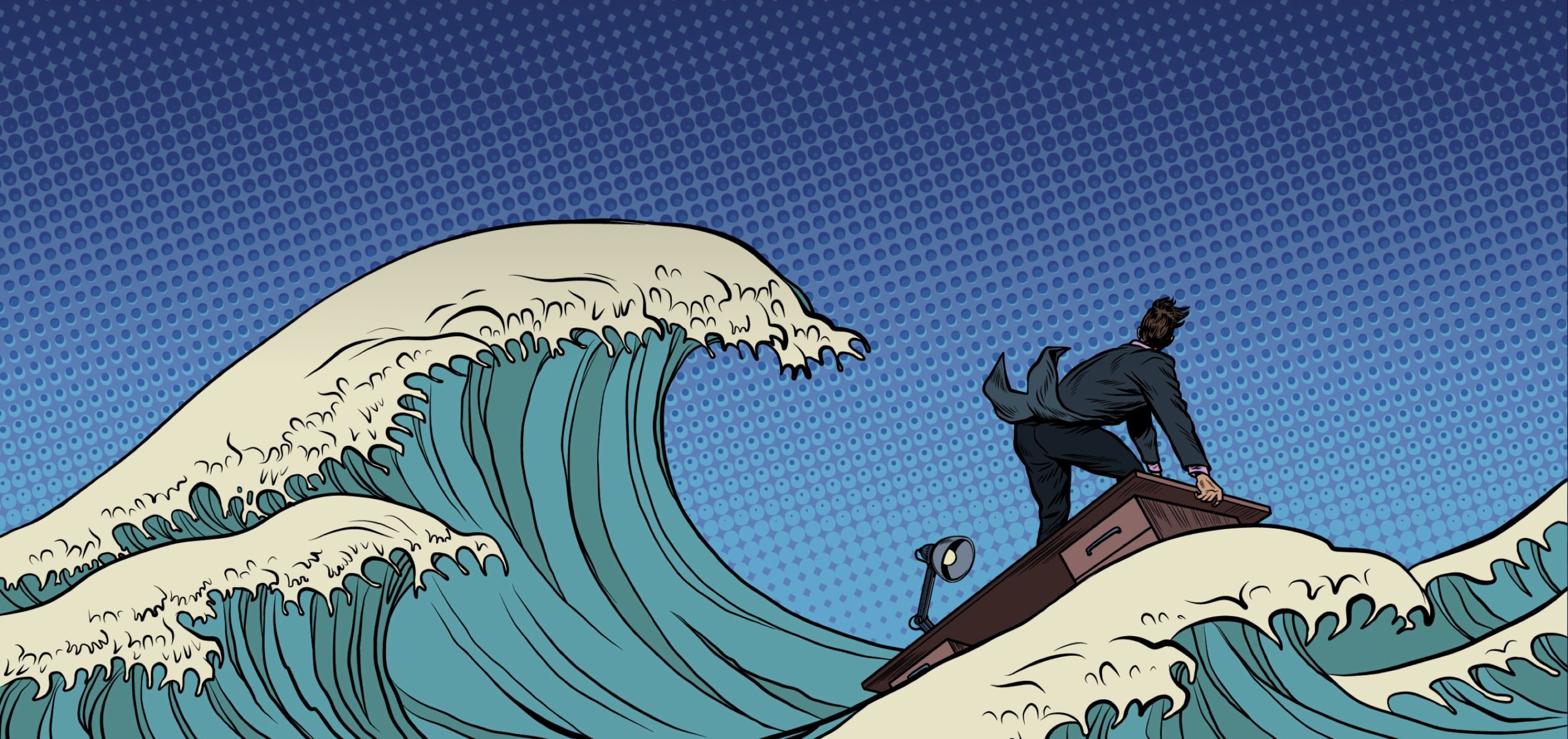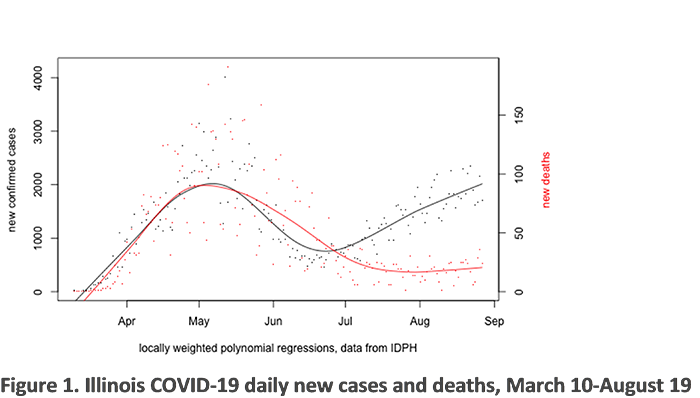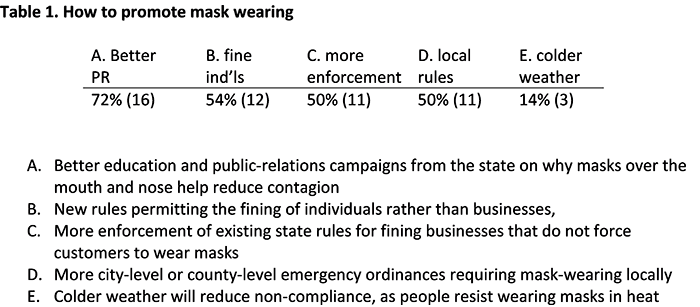
IGPA is developing several Pandemic Stress Indicators, designed to evaluate the social and economic effects of the COVID-19 pandemic on Illinois residents. The Pandemic Stress Indicators grew out of the work on IGPA’s Task Force on the Impact of the COVID-19 Pandemic.
This first stress indicator is a frequent poll of three sets of experts about pandemic policies. Experts on economics, public health, and/or vulnerable populations from across Illinois have generously agreed to provide regular opinions on various pandemic policies. In answering the surveys, all panelists provide only their personal views and do not offer official positions on behalf of their respective institutions.
On August 20, IGPA invited members of our expert panel to complete the seventh wave of our ongoing Pandemic Stress Indicator survey series. These surveys provide regular updates of views of experts in economics, public health and vulnerable populations regarding pandemic policies. We received 22 responses.
Figure 1 shows two important time series for Illinois, confirmed daily new cases of COVID-19 and daily new deaths officially attributed to COVID-19, from March 10 through August 19, as recorded by the Illinois Department of Public Health.
In these data, the two series moved in parallel through mid-May, and then separated as caseload fell more quickly than deaths, as would be expected when deaths lag behind cases. More striking is how new cases have since risen again after flattening in late June, while the number of new deaths each day has been largely flat, with a mean just under 20.

Both series can be understood as estimates, with error, of the true data. Confirmed cases are very likely an under-estimate of actual cases, because testing is far from universal, and COVID-19 can be asymptomatic.
Deaths are possibly an undercount, in the absence of mandatory post-mortems. In the sixth wave of surveys, we asked our panelists if they thought that these official statistics are about right, under-estimates, or over-estimates. Large majorities thought that the official case count is too low (70%) and that the death count is about right (78%). A trickier question is whether the errors, whatever their direction, have been changing over time.
In wave seven, we presented Figure 1 and then asked our respondents if they had “a strong belief or conjecture about why the most recent surge in COVID-19 cases has not (yet) seen a parallel rise in deaths”. Five themes emerged. The most common response was that the age profile of those infected has shifted downward, so that, over time, more of those sick with COVID-19 are younger and less at risk of death.
A related response was that those most vulnerable to the disease have been taking more precautions, an observation that could help explain the change in age of those afflicted. A second point cited by many is that medical care has improved, and hospitals are less overwhelmed by sheer volume of cases so that even those hospitalized have better odds of surviving now than they would have a few months back.
A slightly different take is that the lag time between catching the disease and succumbing could be lengthening so that the echo of the case surge will still show up, but not as quickly as it would have in the spring. Finally, multiple respondents noted that the virus itself could be changing, and/or that less lethal strains of it could be spreading more at present.
On the same topic, we asked respondents to forecast the near future of these trends. The most popular prediction from just under half the respondents (10/22=45%) was that both new cases and new deaths will rise over the next few months. About a quarter (6/22=27%) thought that new cases would keep rising but the new-deaths series would remain flat. Another small group (4/22=18%) expects no rise in deaths and an end to the surge in cases. One respondent predicted a rise in deaths and decline in cases, and a final respondent described a still more complicated pattern.
School’s back on…Make that on(line)
As the survey was launched, a number of schools and prominent universities were revising their instructional plans for the autumn, going to online-only classes at least temporarily, following spikes in cases. We asked about such “quick adjustments,” and whether or not they demonstrated that in-person instruction was premature.
A large majority (16/22=72%) thought that the quick cancellations, quarantines, or postponements showed that in-person instruction at this point in time was, indeed, premature. Another 18% (4/22) thought it too early to say, and only one respondent selected, “These quick adjustments were always part of the plan, and do not prove that it is unwise or impossible to have safe in-person classes yet.”
Mask compliance
On August 7, the Illinois Department of Public Health issued revised rules for mask-wearing, and promoting compliance with requirements to cover faces in public. We asked the experts to select as many options as they liked from a short list of factors that might contribute to greater levels of protective mask-wearing in public. Table 1 shows that the most popular choice was better educational campaigns from the state on why and how to wear masks.
A smaller majority endorsed new rules that shift fines for non-compliance onto individuals not donning masks, rather than businesses that serve such people. Exactly half of the respondents favor more enforcement of existing rules for fines levied on businesses, according to customer non-compliance. The same number, but not precisely the same respondents, support more city- or county-level emergency ordinances, supplementing state laws. Finally, only three respondents saw merit in the claim that colder weather would lead to better compliance because masks are so uncomfortable in the summer heat.

New criteria for restrictions
When Illinois altered the definitions of regions for the purposes of monitoring and controlling COVID-19, in mid-July, it also changed the criteria for when additional mitigation measures are required.
We asked how well the new system seems to be working, so far, offering only three alternatives: “OK”, “too early to tell”, and “not very well.” Respondents split fairly evenly, with 36% (8/22) favorable, and 32% (7/22) each reporting uncertainty or skepticism about the new regime.
Unemployment
We invited economists onto this panel not only because public-health policies entail many cost-benefit comparisons of the sort that are the heart of the study of scarcity, which is one way to see Economics, but also because combatting the pandemic has involved wreaking havoc on the economy, arguably of necessity. We turned to a core economic matter by asking, “The estimated unemployment rate in Illinois leapt from about 3-4% in the early spring to over 17% after the pandemic prompted the governor to order shut-downs. Even with some easing of restrictions, it remains in the vicinity of 15%. What do you think the official state unemployment rate will be by year's end?”
Soon after the survey was composed, the newest data were released, with the estimated rate revised downward from 14.5% (June) to 11.3% (July). All but one respondent was willing to hazard a guess, and the most popular choice, from 41% of the respondents (9/22) was a prediction of “15-20%”, either worsening or unimproved conditions.
Nearly as common was the “status quo” prediction of 11-14 % (no change versus the July estimate and slightly below the June estimate of 14.5%, rounded up in the question text). Nobody predicted unemployment exceeding 20% or under 6%, as the final 4 respondents (18%) predicted a rate in the 6-10% range.
Looking ahead
With university autumn terms underway, many of our panelists and the IGPA PSI investigators are somewhat preoccupied with teaching, and so the survey waves will be slightly less frequent in the near future than the every-two-week summer schedule.
In every wave, we ask respondents for suggestions of important topics not yet covered. Wave seven respondents mentioned both the effects of the election on COVID-19 policy and the effects of COVID-19 on the election, the possibility of the pandemic inducing some long-term shifts in child-care balancing within families, and whether tighter still restrictions on bars are in the offing if the new-case rate does not soon level off.
Appendix. Exact question wording
[response options: new cases will level off or fall and deaths will stay level;
new cases will level off or fall and deaths will start to rise;
new cases will keep rising and deaths will also start to rise;
new cases will keep rising and deaths will stay level;
other]
[response options: These quick adjustments were always part of the plan, and do not prove that it is unwise or impossible to have safe in-person classes yet;
these quick adjustments show that it is premature to be holding in-person classes;
It is still too early to know if in-person classes can work this fall.]
[response options reproduced in text above]
[response options: OK; too early to say / I’m uncertain; not very well]
The estimated unemployment rate in Illinois leapt from about 3-4% in the early spring to over 17% after the pandemic prompted the governor to order shut-downs. Even with some easing of restrictions, it remains in the vicinity of 15%. What do you think the official state unemployment rate will be by year’s end?